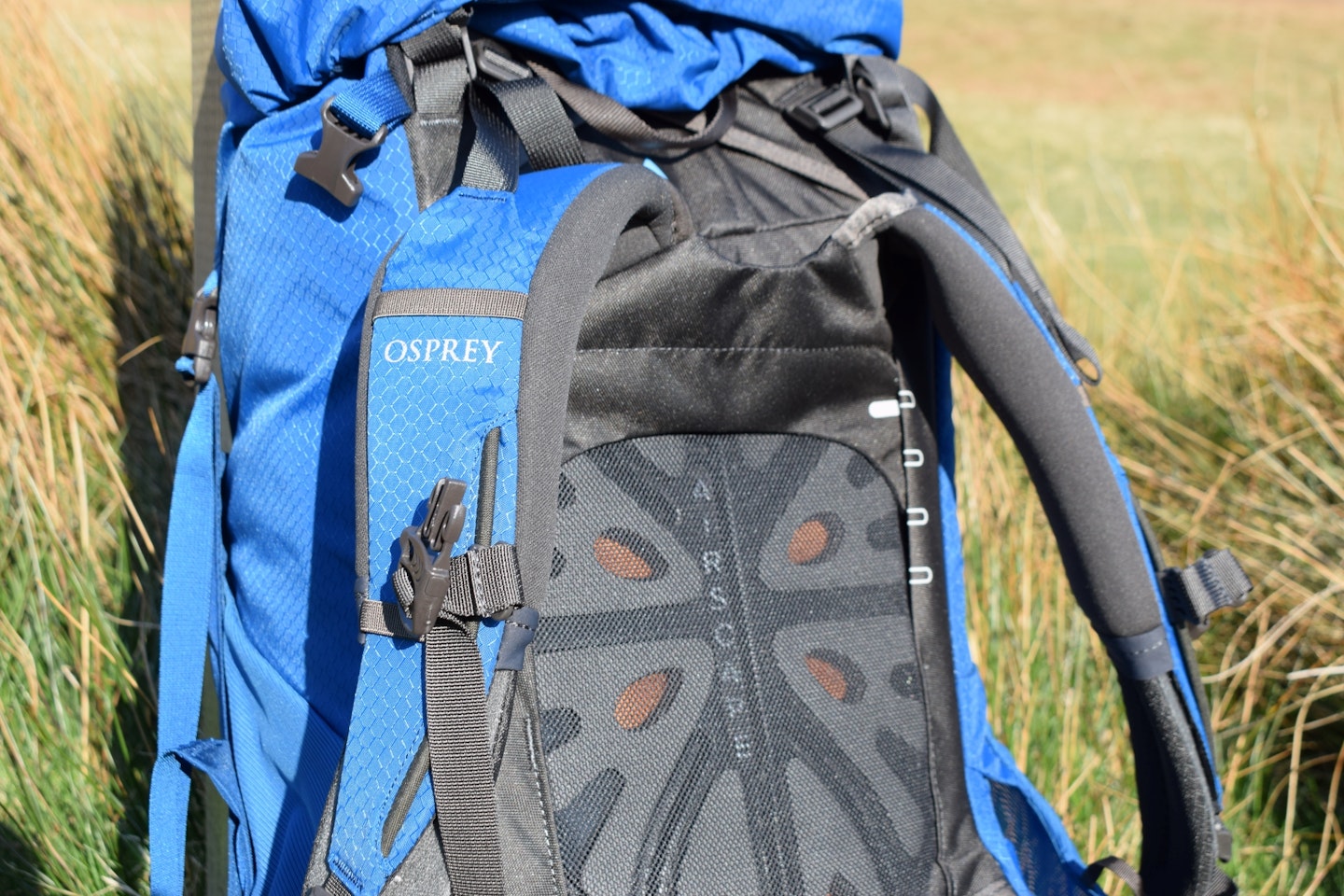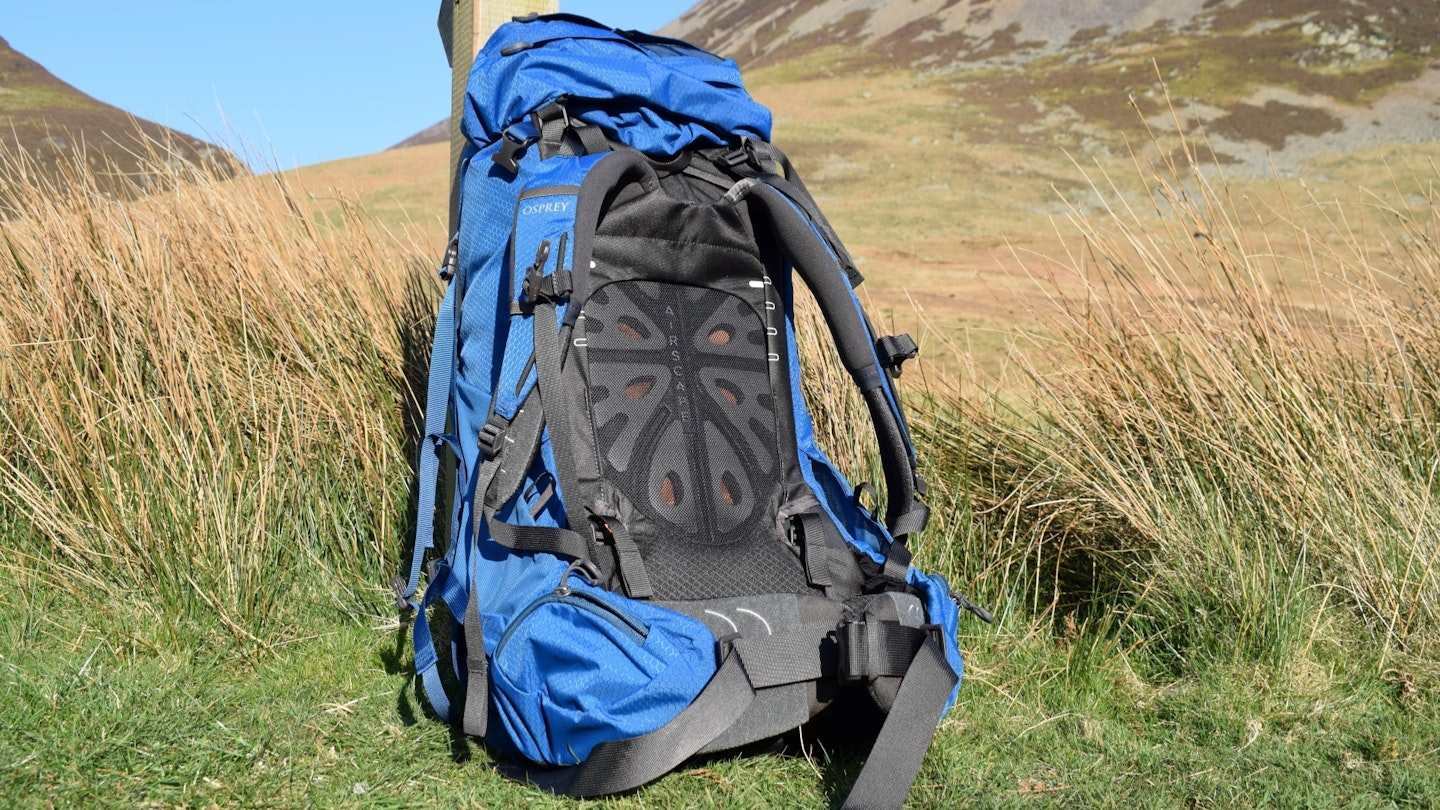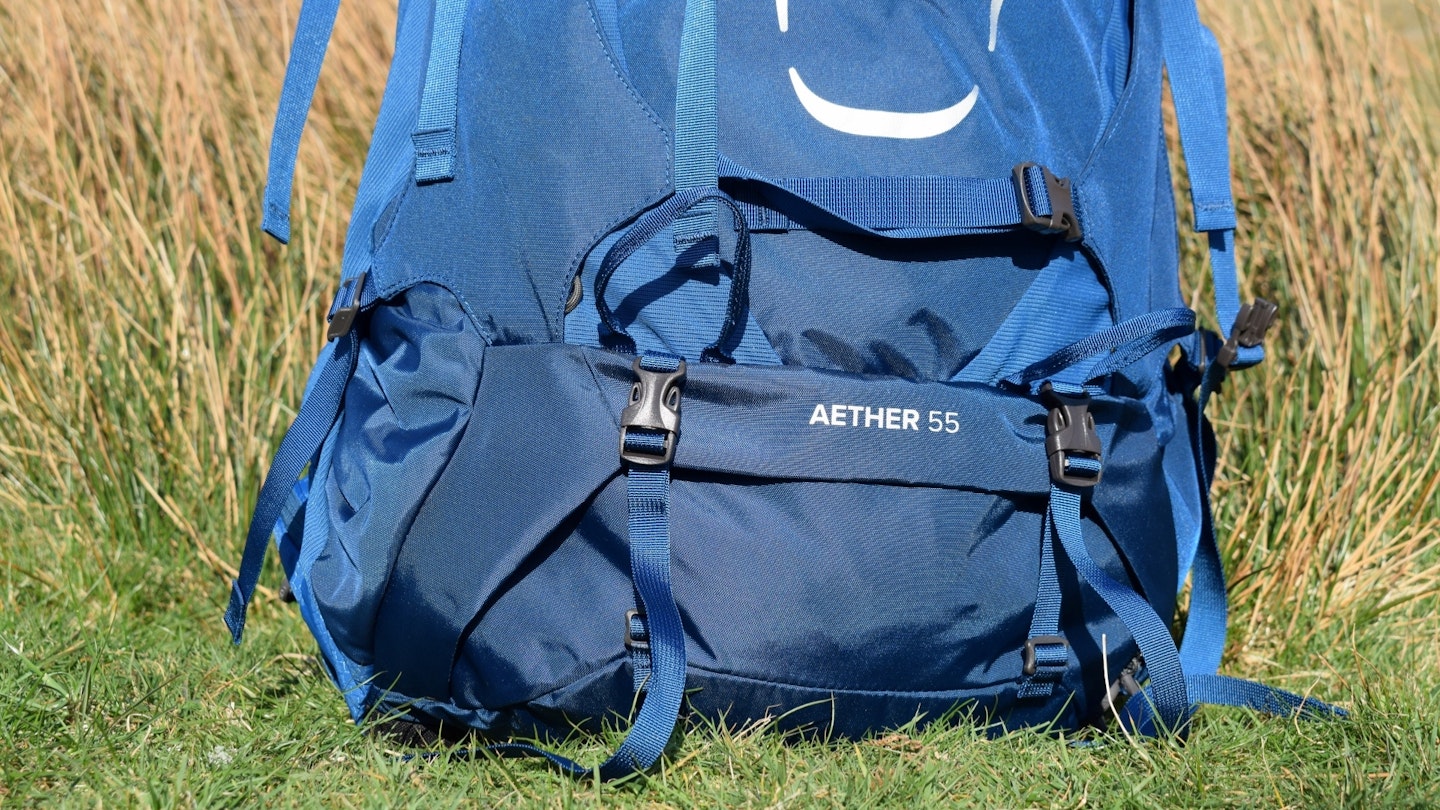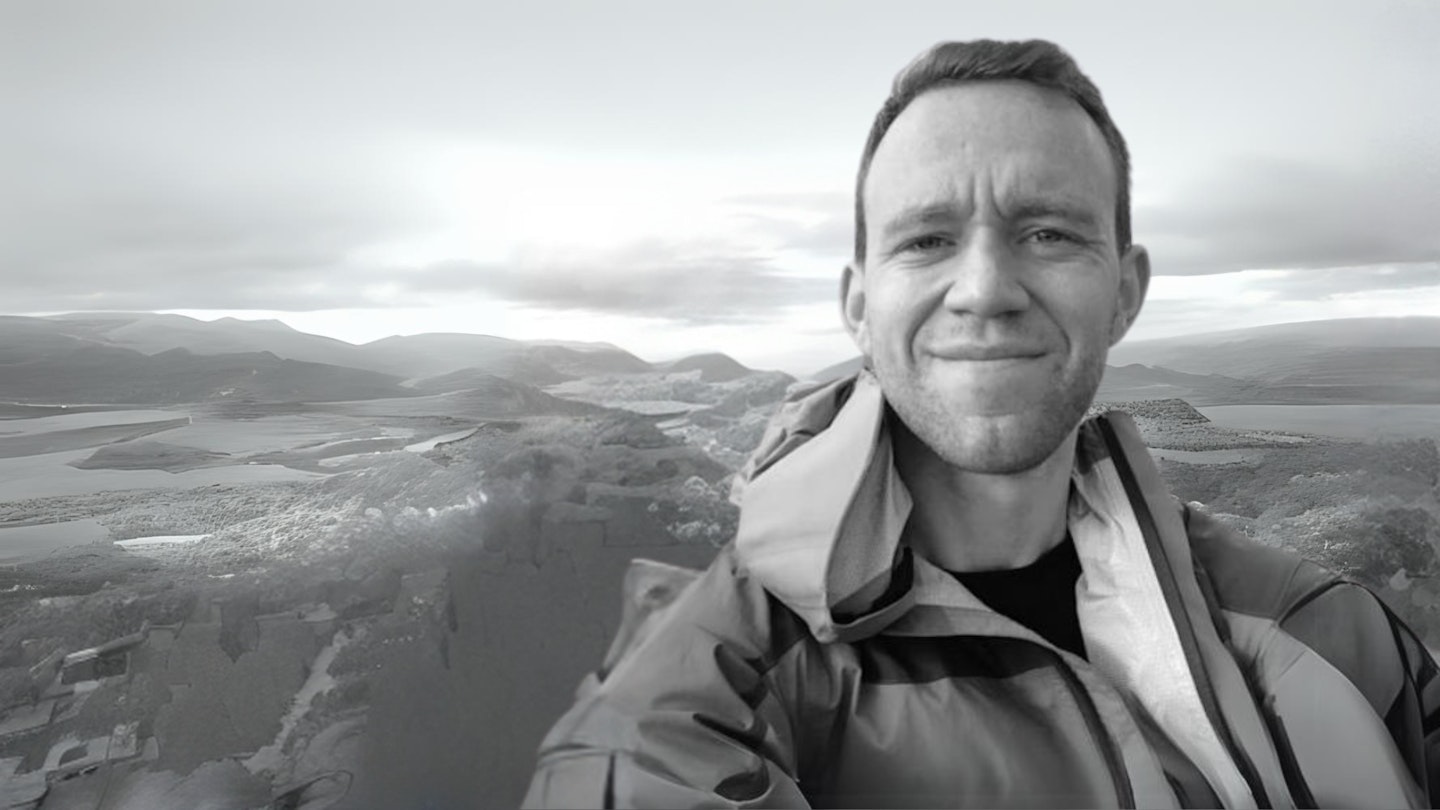Backpack specialist Osprey has a stellar reputation for making fully-featured gear-haulers with high-tech back systems and high load carrying capacities – and the Aether 55 is no exception. As such, it’s one of those chunky hiking backpacks that will polarise opinion.
If you’re trying to keep your pack weight to a minimum, look elsewhere – the 2,189g Aether is too heavy and lacking in streamlined sleekness for you. But, instead, if you prioritise long-term durability, maximum features and high load carrying capacity (up to a whopping 27kg), the Aether will be ideal for you.
The back system, featuring Osprey’s AirScape technology, pairs an injection moulded framesheet with foam cutouts and a layer of tight mesh. This delivers a stable, close-to-the-body carrying experience. You get good load transfer through the chunky hipbelt, although the back panel’s straight, rigid-ish feel prioritises heavy load functionality over pure comfort. Ventilation is pretty decent, too.
The Aether 55 is certainly fully-featured, with all of the bells and whistles. For some this might feel over-engineering and excessive; others will love the approach.
To name but a few, my favourite features are the curved zipper for access to the main compartment, the floating lid with two zippered pockets, and the on-the-go access to the side water bottle pockets.
Find the women's version here.
Pros
- High-tech back system
- Loads of top-tier features
- Very durable
- Osprey’s craftsmanship
Cons
- Very heavy
- Expensive
- Doesn’t feel light or agile or streamlined
| RRP: | £199.99 / $299.99 |
| Weight: | 2,189g / 4lb 13oz |
| Volume: | 55L |
| Back sizes: | S/M, L/XL |
| Versions: | 55L, 65L, Ariel 55, Ariel 65 |
| Main fabrics: | 420-denier nylon with DWR |
Back system: Panel, frame and harness
I like this pack’s back system. It works well, feels comfortable and transfers the load to the hips nicely. The shoulder straps hug the body securely, the pre-curved and chunky hipbelt does its job effectively and the overall sensation is of a stable, close-to-the-body carrying experience. The back panel feels somewhat rigid, with a straight and flat feel – but it’s comfy enough, too.
Overall I’d describe this back system as well-designed for carrying heavier loads on the trail. As such, it will polarise opinion. If you’re trying to minimise your base weight and go as ultralight as possible, or if you’re only camping in spring and summer for one night only with a lighter load, then don’t bother with this pack – it’s overkill for your needs.

However, if your base weight (the weight of your tent, sleeping bag, sleeping mat and camping stove) is on the heavier side of the spectrum, or if you’re taking on a long-distance, multi-day trail and need to carry lots of food, this pack has the gear-hauling load capacity you need. It’s suitable for loads from 13kg to 27kg, according to the backpack’s official specifications.
For the gear geeks out there, here are the details of the Osprey Aether 55’s back system. You get Osprey’s AirScape Suspension technology, which pairs an injection moulded framesheet with foam cutouts and a covering of tight mesh.
At the base there’s a mesh-covered foam lumbar pad, too. Overall, this system creates a "breathable, close-to-body fit" which is "ideal for managing heavier loads", according to Osprey.
Back length and sizing

Off the shelf, the Osprey Aether 55 is available in two back lengths: small/medium or large/extra-large size. I’m 178cm tall with a slim, athletic build and I tested the small/medium version, which worked fine for me.
The Osprey size guide suggests the small/medium version is suitable for torso lengths from 17in/43cm to 21in/53cm (measured from the iliac crest to the C7 vertebrae), while the large/extra-large option is suitable for 19in/48cm to 23in/59cm.
The torso length of each pack is also adjustable on-the-go for a fine-tuned fit to your body shape. On the back panel, there are four white marks indicating different positions for the shoulder straps to sit.
By releasing the 'ladder lock' straps, which are located on either side of the lumbar pad, the shoulder harness will slide up and down the pack’s LightWire frame, thus lengthening or shortening the torso position. Simply find the right position for you, re-tighten the ladder locks and you’re good to go.
Volume, shape and weight
As the name suggests, the Aether 55 has a 55L volume which, for many people wild camping, will be sufficient space for their overnight kit. The pack’s shape is pretty standard. Its dimensions are quite 'normal' with agreeable proportions, but it’s perhaps slightly taller than some other packs.
Certainly it has more of a tall and thin profile, than a short and wide one. Overall, however, it’s a classic backpack shape with nothing out of the ordinary. It works well and there’s nothing to dislike, in terms of the shape.
The weight of the Aether 55, however, is more likely to polarise opinion. With an official weight of 2,189g, this pack is very heavy – more than double the weight of the Atom Packs The Prospector EP60 (965g), for example, and around 500g+ heavier than many other fully-featured packs such as the Gregory Paragon 50.
If you’re trying to go ultralight, and like to feel fast and agile in the mountains, the Aether’s excessive weight will probably be a deal-breaker – 2,189g is just too heavy.

However, you do get some benefits for this extra weight. The Osprey Aether’s super-thick and tough 420-denier nylon fabric feels bombproof and is likely to deliver excellent long-term durability, while the sturdy and robust construction ensures a humongous load capacity up to a maximum of 27kg, according to Osprey.
That’s obviously pushing it to the extreme, but clearly this is a competent gear hauler. Finally, you also get loads and loads of features, which also add to the pack’s overall weight.
Therefore, if you favour long-term durability, features and a high load capacity, this pack is a good choice for you. But if you’re aiming for a light and agile approach to backpacking, you need to look elsewhere.
Other sizes in the range include the Aether 65 (£270), as well as the Aether Plus 70 (£350), Aether Plus 85 (£360) and Aether Plus 100 (£375), all of which have integrated daypacks, a rather niche feature. The women’s version of the Aether is called the Ariel. It's available in several volumes, includes the Ariel 55 (£260), Ariel 65 (£270), Ariel Plus 70 (£350) and Ariel Plus 85 (£360).
Osprey also makes the Aether and Ariel in an 'extended fit' version suitable for plus size body shapes, while the Aether and Ariel Pro versions are billed as “stripped down, streamlined and svelte” alternatives to the regular Aether or Ariel options.
Features: Lid, straps, pockets and weather protection

It would definitely be fair to describe this pack as fully-featured – it has a comprehensive feature-set with very little lacking. Let’s try and go through it all.
Atop the pack is a floating-style lid, with two zippered pockets, one of which houses the included rain-cover. The rain-cover has a PFC-free DWR treatment and includes a drawcord toggle for cinching it tightly around your pack.
This will add a nice layer of weather protection to your pack, although, based on experience, personally I’m not a massive fan of external waterproof covers – in strong winds they can flap around noisily and have a tendency to fly off if you’re not careful.
At the front of the pack you get a 'shove-it' stash pocket for stowing items like a waterproof jacket, litter or anything else you want. The design has pros and cons.
It’s far more sturdy and strong than the front pockets of many other backpacks, being made from a sturdy, reinforced fabric. However it is way less stretchy and voluminous than mesh pockets. I’m not too convinced of Osprey’s approach, in this instance.
On both sides of the pack you get stretchy side pockets, with dual-access entry points, meaning you can grab a water bottle on-the-go without stopping your hike – it’s a nice touch. Each hipbelt pocket also has a zippered pocket, which is big enough to accommodate my oversized Samsung S22+ phone.

These pockets are ideal for snacks, sun cream, valuables or other little items you like to keep close or have access to regularly. There aren’t any pockets on shoulder straps, but there are little loops and toggles for attaching a GPS or similar devices, if needed.
Other features include dual ice axe loops with bungee tie-offs, removable sleeping pad straps (for storing a closed cell foam sleeping mat externally) and an internal hydration reservoir sleeve with perforation for the hose.
You also get a large, looped, zippered access to the main compartment, which enables you to locate items easier than if you’d have to rummage around top-down. At the base of the pack, there’s a zippered sleeping bag compartment too, with a removable divider.
Or, in other words, this pack has all of the bells and whistles, with a fully-featured approach. For most backpackers, all of the features will prove practical and functional – but it’s worth remembering that they do come at a weight penalty.
Verdict
A fully-featured gear hauler with a high-tech back system and good load capacity – but it’s very heavy and expensive.
If you're looking for a reliable backpack with a similar capacity but much lighter weight, check out our Osprey Eja Pro 55 review and compare.
Shop this product
About the author

James Forrest writes regular features and route guides for Trail and LFTO, and has been one of our main gear testers for the last few years. James is based on the edge of the Lake District so when he isn’t off on his latest crazy adventure or challenge, he’s walking in his local fells.




